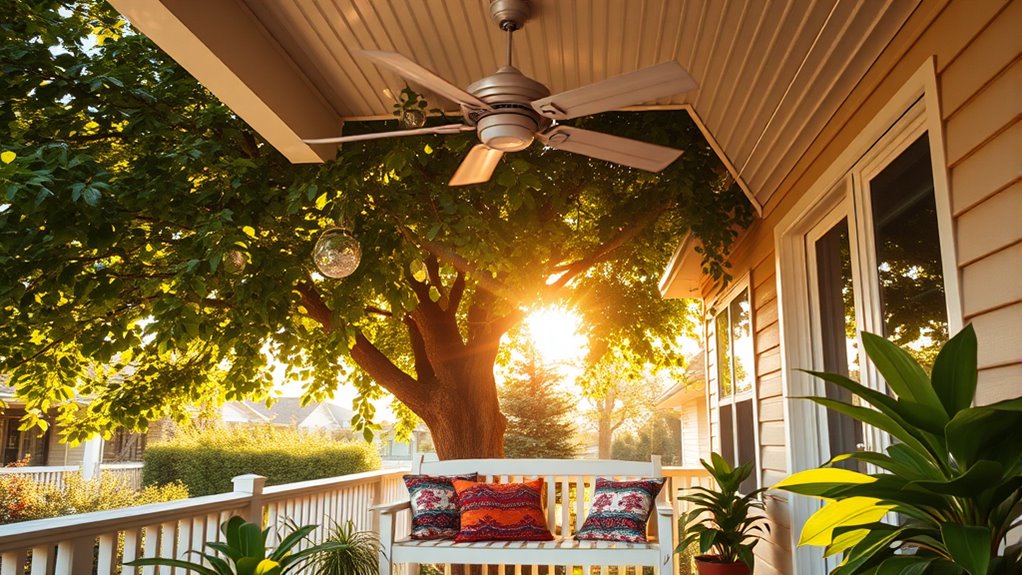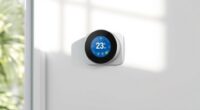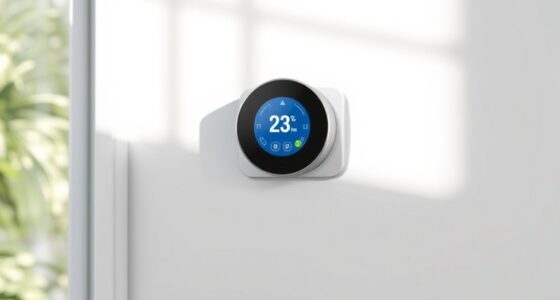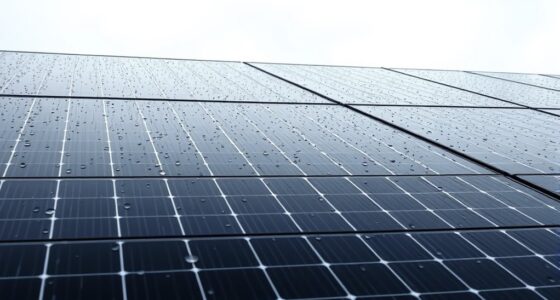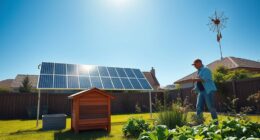To cool your home without AC, start by opening windows on opposite sides to create cross-ventilation and let cool breezes flow through. Use shading devices like curtains, blinds, or external awnings to block heat gain from sunlight. Incorporate evaporative cooling by placing damp cloths or shallow water pans near windows, and install reflective surfaces to deflect sunlight. Adding fans and optimizing your interior layout can boost airflow. Explore these simple strategies to make your space more comfortable without turning on the AC.
Key Takeaways
- Use evaporative cooling by placing damp cloths or water pans near open windows to lower indoor temperatures.
- Maximize cross-ventilation by opening windows on opposite sides during cooler times of the day.
- Install external shading like curtains, awnings, or reflective surfaces to block heat before it enters the home.
- Improve insulation and arrange furniture to promote better airflow and prevent heat buildup indoors.
- Enhance passive cooling with ceiling fans, reflective surfaces, and planting shade trees around your home.
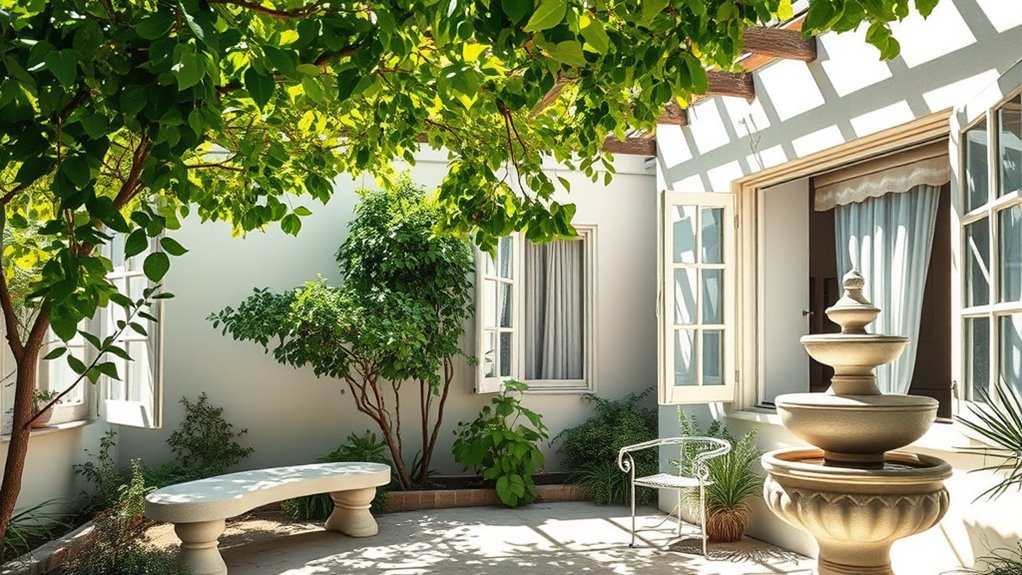
When summer heat becomes overwhelming, passive cooling hacks offer an eco-friendly and cost-effective way to keep your home comfortable without relying on air conditioning. One of the most effective strategies is utilizing evaporative cooling, which mimics nature’s own process of cooling through water evaporation. If you have traditional or even modern windows, you can enhance this method by placing a damp cloth or a shallow pan of water near open windows. As the air flows through, it absorbs moisture, lowering the indoor temperature naturally. This approach works best in dry, arid climates, but can still provide noticeable relief in other areas. The key is to create a constant flow of fresh, cool air into your space, which brings us to the importance of natural ventilation.
Natural ventilation is all about optimizing airflow within your home to prevent heat buildup. You can achieve this by strategically opening windows and doors on opposite sides of your house to create cross-ventilation. This allows cooler air to enter and warmer air to escape, reducing indoor temperatures without any mechanical help. To maximize this effect, consider installing window vents or using window fans that work with the prevailing breezes. During the hottest parts of the day, keep windows open early in the morning and late in the evening when outside temperatures are cooler. Closing them during peak heat hours can trap the cooler air inside. Additionally, shading windows with curtains, blinds, or external awnings helps prevent heat from entering in the first place, making natural ventilation even more effective. Moreover, adding proper insulation to your walls and roof can significantly reduce heat transfer, keeping indoor temperatures lower for longer periods.
You can also improve airflow by positioning furniture and interior layouts to avoid blocking vents and windows. Light-colored or reflective exterior surfaces can deflect sunlight, reducing heat gain. Planting trees or installing trellises with climbing vines near windows creates natural shade, further lowering indoor temperatures. Using ceiling or oscillating fans in tandem with natural ventilation enhances comfort by circulating air and preventing stagnant pockets of hot air from forming. Remember, the goal is to encourage a steady exchange of air that keeps your home cool without resorting to energy-intensive cooling systems.
Frequently Asked Questions
How Effective Are Passive Cooling Methods in Extremely Hot Climates?
In extremely hot climates, passive cooling methods can be quite effective if you use them correctly. Evaporative cooling works well, especially in dry environments, by adding moisture to lower temperatures. You should also leverage thermal mass, like thick walls or concrete floors, to absorb heat during the day and release it at night. Combined, these strategies reduce indoor temperatures naturally, making your home more comfortable without relying on air conditioning.
Can Passive Cooling Techniques Be Combined With Traditional Air Conditioning?
Some might think passive cooling and traditional AC can’t work together, but hybrid systems prove otherwise. You can combine passive strategies like shading and ventilation with retrofit strategies that integrate smart controls for your existing AC. This approach reduces energy use while maintaining comfort. By blending these methods, you get a more sustainable solution that leverages the strengths of both passive and active cooling, especially in hot climates.
What Are the Best Materials for Passive Cooling in Different Home Types?
To optimize passive cooling, you should focus on materials suited to your home type. Thermal insulation keeps heat out in warmer climates, while reflective roofing deflects sunlight, reducing indoor temperatures. For smaller homes, lightweight materials work best, whereas thicker insulation suits larger spaces. You’ll want to choose materials that enhance airflow and shade, making your home naturally cooler without relying on AC.
How Much Can Passive Cooling Save on Energy Bills Annually?
You might wonder how much you can save with passive cooling. By implementing these methods, you could see significant cost savings annually. Passive cooling reduces energy bills by cutting down on air conditioning use, leading to substantial energy reduction. On average, households can save hundreds of dollars each year, depending on climate and home size. Embracing passive cooling not only lowers costs but also benefits the environment.
Are Passive Cooling Hacks Suitable for All Building Sizes and Designs?
Think of passive cooling like a gentle breeze—it’s adaptable but not a one-size-fits-all solution. You’ll find that building constraints and design limitations can affect its effectiveness. Smaller or well-ventilated structures often thrive, while larger or oddly shaped buildings may need additional strategies. So, it’s essential to evaluate your specific space and limitations before diving into passive cooling hacks. Tailor your approach for the best chill without the chill of high energy bills.
Conclusion
By trying these passive cooling hacks, you can lower your home’s temperature naturally and save energy. Remember, a penny saved is a penny earned, so small changes can make a big difference. Embracing these eco-friendly strategies not only keeps you comfortable but also benefits the planet. With patience and persistence, you’ll find that sometimes, the simplest solutions are the most effective. After all, slow and steady wins the race, even in cooling your home.
